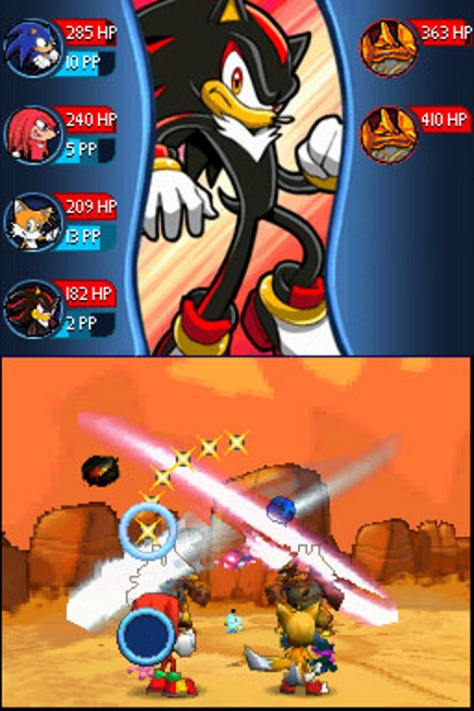
Released for the Nintendo DS in September 2008, Sonic Chronicles: The Dark Brotherhood is one of the most unique games in the iconic series. Unlike almost every other entry in the franchise, it eschews fast-paced platforming in favor of turn-based battles. This is unsurprising considering BioWare, the Edmonton, Alberta-based developer responsible for it, is best known for their various role-playing games. It features a few trademarks associated with their gameography but plays more like their spin on the Japanese RPG.
A calamity has befallen the world of Sonic and this time, it’s not caused by Dr. Eggman. In fact, the stakes are so high that he eventually joins forces with the Blue Blur. No, instead a race of echidnas long ago banished to another dimension has stolen the all-powerful Chaos Emeralds. Although the original plan was merely to return to Earth, the beguiling leader of the Nocturnus Clan of echidnas, Imperator Ix, has been corrupted by power and desires nothing less than total domination. Defending their world and rescuing the alien worlds under Ix’s rule becomes an all hands on deck affair, and Sonic was promptly joined by Tails, Knuckles, and all the usual suspects.
Each character had unique movement abilities that were necessary to fully explore the environments they found themselves in. Naturally Sonic could run fast and utilize the shuttle loops common to the series whereas Tails could fly across gaps and Knuckles was able to climb sheer cliffs. It didn’t take me long to realize how important party composition was, and that I needed to have a balanced foursome. This was especially true in regards to combat.

Akin to each party member’s unique movement ability, everyone had a distinctive selection of POW moves in battle. These were their powerful special attacks and status-inflicting moves. When forming a party, I found it vital to always include one of the healers so I wouldn’t have to rely on items. Among the ten playable characters, most everyone else was focused on dealing damage or debuffing foes. But, perhaps even more crucial than having a healer was having someone who knew armor-piercing attacks.
Enemies varied based on the environment or planet I encountered them, and so too did the strategy required to defeat them. This wasn’t a game where I could solely rely on the basic attacks to overwhelm foes. By far the most annoying concept I had to deal with was armored enemies. Any standard attack or POW move would only do a single point of damage against these enemies. So, if I failed to include a party member who knew an armor-piercing attack, I was in for a long, drawn-out battle. It only took a couple of battles like this to ensure I always included someone who could counter these foes.

In combat, allies and foes took turns like many other RPGs but like Shadow Hearts, I had to remain involved to secure victory. Each round would allow for characters to undertake multiple actions. Fast characters like Sonic and Shadow were granted three actions, while a slower character like Big the Cat only had one. This structure, and a variety of combo attacks, allowed for fairly intricate strategies. It was all for naught if I couldn’t execute POW moves, which would outright fail if I couldn’t complete Elite Beat Agents styled touch-screen interactions. These weren’t tough but it was so frustrating when I missed one cue and the POW move failed.
Party members could be bolstered by gear but with a set amount of money in the world, collectible rings in each area, it obviously wasn’t a focus. Chao, the cute little creatures introduced in Sonic Adventure were seemingly more important. They were collected while exploring environments, granted special powers when equipped, and could even be leveled up by trading with friends. Speaking of friends, Tails and Eggman, the two brainiacs of the bunch exhibited chummy chemistry despite their radically different philosophies. Their interplay and the general storyline and dialogue, while skewing young, was entertaining. Additionally, the plentiful conversation responses and even the inclusion of a codex reinforced this was a BioWare game, although nowhere near as fleshed out as Mass Effect.

Despite overtures suggesting a sequel during the ending, that title never materialized, which is a shame. Sonic Chronicles: The Dark Brotherhood is the sole RPG in the series and it’s a wonderful addition. The storyline and dialogue played within the established boundaries of the world but BioWare still managed to have some fun with the characters. And the combat, influenced by JPRGs, was a similarly fresh take on a known quantity. I had to learn through failure a few times, either to pay attention in battle or balance my party, but it was worth it to experience the totality of this enjoyable gem.
